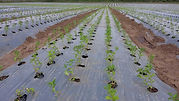
Bed Preparation
After achieving proper tilth in the soil, the next operation for bed making starts. Stevia grows best on raised beds in almost all soils. The dimensions of the beds depend on the target plant population density, local agroclimate, adopted irrigation system and soil conditions. I am describing here a specific case with high target population density of 165,000 plants per ha.
There is no limitations about the length of the bed.....that is to be determined according to the land situation and the irrigation system. There is a limitation of maximum drip line length for drip irrigation and the bed length should not exceed that. The dimensions across the width of the bed is very important for determining the overall plant density, ease of agronomic operations like weeding and harvesting and surface drainage. The following diagram represents a typical cross section of a bed and adjacent furrow.

The bed dimensions has also to be compatible with the wheel width of the tractor, so that the tractor can move freely over the bed and its wheels can be accommodated within the furrow. This will facilitate the use of the tractor for mulch and drip hose laying, agro-chemical spraying, harvesting and other agronomic operations. Common 50HP tractors usually fits in the bed and furrow systems with abovementioned dimensions. Sometimes the tractor needs to be retrofitted with narrower rear wheels.



After the bed making, the next step is installation of the irrigation system. In most of the areas, drip irrigation is the preferred choice because it gives maximum water use efficiency. On the beds with the abovementioned dimensions, generally three parallel drip lines are required. The following diagram shows the placement of the drip lines. The drip lines have 12 mm diameter and drip nozzles at 20 cm spacing.


Drip irrigation may not be suitable for all situations. In some cases, sprinkler or pivot irrigation is more viable options. The optimal irrigation system for certain location is to be decided on the basis of farm topography, water availability and local agroclimate. The layout of the drip irrigation is also to be optimized on the basis of specific farm situation.

After drip hose laying, the next step is laying the mulch. Heavy plastic mulch with black surface in one side and white surface in the other side is often the most suitable option. For beds, with the shown dimensions, mulch with 150 cm width is suitable. The mulch can be laid either with a tractor drawn mulch layer, or by manually unrolling rolls of mulch on the beds. The later method may be adopted when the bed length is smaller. The mulch should stay flat on the bed surface and the sided of the mulch should be covered with soil so that the mulch remains in place properly. Mulch with pre-made holes at proper spacing saves a lot of manual labour input.



For stevia in temperate and tropical climates, Silver mulch is often the best option. Silver mulch combines its unique reflective properties with standard black plastic mulch's strengths (providing a weed barrier, moderating soil temperature, etc.). This combination produces a plastic mulch that scatters light in way that has been proven to reduce the ability of certain insect pests, including aphids and flea beetles, to infest crops.Silver mulch also reflects sunlight back into the plant canopy, and the additional light helps plants grow bigger and more quickly than they would with light-absorbing black plastic mulch.
Plant spacing
For high density farming, often 20 cm x 20 cm plant spacing is used. The following figures depict the spacing. Not all varieties are compatible with this spacing and a judicious decision is to be taken on the basis of target plant population in the field – which in turn depends on soil fertility status, irrigation infrastructure, farming system (organic/conventional) and agro-climate.







Different Plantation Systems
6 lines in each bed
5 lines in each bed
4 lines in each bed
3 lines in each bed
2 lines in each bed






